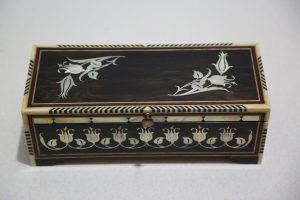Decorative Elements
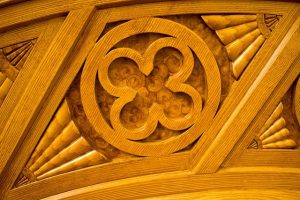 Wood inlays are decorative elements that involve embedding pieces of wood into a larger wood surface to create a design or pattern. Inlays can be made from different types of wood, such as contrasting colors or textures, to create a visually striking effect.
Wood inlays are decorative elements that involve embedding pieces of wood into a larger wood surface to create a design or pattern. Inlays can be made from different types of wood, such as contrasting colors or textures, to create a visually striking effect.
There are several types of wood inlays, including:
- Banding inlays: These inlays involve creating a narrow band of wood, which is typically used to decorate the edges of furniture or other wood surfaces.
- Marquetry inlays: These inlays involve creating a design or picture using different colors and types of wood, which are cut into thin pieces and fitted together to form the desired pattern.
- Parquetry inlays: These inlays involve creating geometric patterns using small wood pieces, which are arranged in a repeating pattern to create a larger design.
Unique Design
Wood inlays can be applied to a variety of wood surfaces, including furniture, flooring, and decorative objects. They are often created by skilled artisans who use specialized tools and techniques to create intricate and detailed designs.
Inlays can add a beautiful and unique touch to wood surfaces, and they can be used to create both traditional and contemporary styles. If you are interested in wood inlays, there are many resources available to help you learn more about this art form, including books, online tutorials, and classes offered by woodworking schools and other institutions.
Artisan
You could, of course, contact an experienced artisan who can create a design and inlay it for you to a piece of your choice.
Guitars
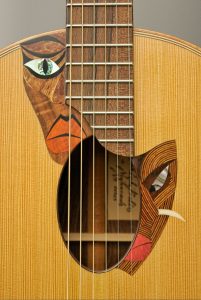 Wood inlays are commonly used in guitars, particularly in the fingerboards and headstocks. The most common type of inlay used in guitars is called a “fretboard inlay,” which involves embedding pieces of wood or other materials into the fingerboard to create a design or pattern.
Wood inlays are commonly used in guitars, particularly in the fingerboards and headstocks. The most common type of inlay used in guitars is called a “fretboard inlay,” which involves embedding pieces of wood or other materials into the fingerboard to create a design or pattern.
Fretboard inlays can be made from a variety of materials, including different types of wood, mother-of-pearl, abalone, and other materials. Some common types of fretboard inlays include dots, diamonds, and other geometric shapes, as well as more elaborate designs, such as vines, flowers, and animals.
In addition to fretboard inlays, some guitars also feature inlays on the headstock, which can include the name of the guitar maker or other decorative elements.
Creating wood inlays for guitars is a specialized skill that requires precision and attention to detail. Many guitar makers work with skilled artisans to create custom inlays for their instruments. In some cases, the inlays are created by hand using specialized tools and techniques, while in other cases, computer-aided design and manufacturing (CAD/CAM) technology is used to create the inlays.
Overall, wood inlays are an important and visually striking element of many guitars, and they can add to both the aesthetic appeal and value of the instrument. Contact an experienced luthier and artisan to discuss having a guitar made for you or inlays added.
Banding Inlays
Banding inlays are decorative elements that involve adding narrow strips of contrasting wood to the edges of a larger wooden surface. This technique has been used for centuries in the production of furniture, musical instruments, and decorative objects.
Banding inlays are typically made by cutting thin strips of wood to the desired width and thickness, and then gluing them to the edge of the main wooden surface. The strips can be made from the same type of wood as the main surface, or from a contrasting wood to create a decorative effect.
Some common types of banding inlays include simple lines, geometric shapes, and intricate patterns. In some cases, banding inlays may also incorporate other decorative elements, such as metal or stone.
The process of creating banding inlays requires a high level of skill and attention to detail. The strips of wood must be precisely cut and fitted together to create a smooth and seamless appearance. The inlays must also be sanded and finished to match the main surface, creating a cohesive and integrated look.
Banding inlays can add a touch of elegance and sophistication to wooden surfaces, and they are often used in high-end furniture and decorative objects. They can also be used to create a more customized look, allowing for the incorporation of unique and personalized designs.
Marquetry Inlays
Marquetry inlays are a decorative woodworking technique that involves using thin pieces of wood, or other materials, to create intricate designs and patterns on a larger wooden surface. The technique has been used for centuries to adorn furniture, musical instruments, and decorative objects.
The process of creating marquetry inlays typically involves the following steps:
- Designing the pattern: The first step in creating a marquetry inlay is to design the pattern that will be used. This can be done by hand, using a drawing or other reference, or with the aid of computer-aided design (CAD) software.
- Cutting the pieces: Once the pattern has been designed, the pieces of wood are cut into thin strips, typically no more than 1/8 inch thick. The pieces may be cut using a handsaw, or with the aid of a scroll saw or other specialized cutting tool.
- Assembling the pattern: The pieces of wood are then assembled to create the desired pattern or design. This may involve cutting the pieces into smaller shapes, or arranging them to create a larger image.
- Gluing the pieces: Once the pattern has been assembled, the pieces are glued to a larger wooden surface, such as a tabletop or cabinet door. The glue is typically applied to the back of the individual pieces, using a small brush.
- Sanding and finishing: Once the glue has dried, the inlay is sanded and finished to match the surrounding wood. This may involve using a combination of hand sanding and specialized finishing techniques to create a smooth, seamless appearance.
Marquetry inlays can be made using a variety of wood species, and can incorporate other decorative materials, such as mother-of-pearl, bone, or metal. The technique allows for a high degree of customization and artistic expression, making it a popular choice for high-end furniture and other decorative objects.
Parquetry Inlays
Parquetry inlays are a decorative woodworking technique that involves creating geometric patterns and designs using small, individual pieces of wood. The technique is often used to create decorative flooring, as well as decorative panels and other decorative objects.
The process of creating parquetry inlays typically involves the following steps:
- Designing the pattern: The first step in creating a parquetry inlay is to design the pattern or design that will be used. This may involve creating a complex geometric pattern or a simple repeating design.
- Cutting the pieces: Once the pattern has been designed, the individual pieces of wood are cut to size using a table saw or other cutting tool. The pieces are typically no more than 1/4 inch thick.
- Assembling the pattern: The individual pieces of wood are then assembled to create the desired pattern or design. This may involve cutting the pieces into smaller shapes, or arranging them to create a larger image.
- Gluing the pieces: Once the pattern has been assembled, the pieces are glued to a larger wooden surface, such as a flooring substrate, tabletop, or panel. The glue is typically applied to the back of the individual pieces, using a small brush.
- Sanding and finishing: Once the glue has dried, the inlay is sanded and finished to match the surrounding wood. This may involve using a combination of hand sanding and specialized finishing techniques to create a smooth, seamless appearance.
Parquetry inlays can be made using a variety of wood species, and can incorporate other decorative materials, such as stone, metal, or other types of wood. The technique allows for a high degree of customization and artistic expression, making it a popular choice for high-end flooring and decorative objects.
Durability
Parquetry inlays can be very durable and long-lasting if they are properly installed and maintained. In fact, parquetry flooring was a popular choice in many historic buildings because it is not only beautiful but also durable and practical.
The durability of parquetry flooring depends on a number of factors, including the type of wood used, the thickness of the inlay pieces, and the finish that is applied. Harder woods, such as oak, hickory, and maple, are often used for parquetry flooring because they are less likely to dent or scratch.
In addition to the type of wood, the thickness of the inlay pieces can also affect the durability of the flooring. Thicker pieces may be more durable than thinner ones, as they are less likely to crack or chip.
Finally, the finish that is applied to the flooring can also affect its durability. A high-quality finish, such as a polyurethane or oil-based finish, can provide a protective layer that helps to resist wear and tear.
With proper installation and maintenance, parquetry flooring can be a beautiful and long-lasting addition to any home or commercial space. Regular sweeping and cleaning, along with occasional refinishing, can help to maintain the beauty and durability of the flooring over time.
Wood Inlays On Furniture
Wood inlays can be applied to a wide range of furniture pieces, including tables, cabinets, desks, chairs, and even beds. Inlay work can be used to add a decorative element to furniture or to create intricate designs and patterns that are both beautiful and functional.
Inlaid furniture has been popular for centuries, and it can be found in many different styles and design traditions. For example, inlaid furniture was particularly popular in the Baroque and Rococo periods in Europe, where it was used to create opulent and ornate designs. In the Art Deco era of the early 20th century, inlaid furniture was often characterized by bold geometric patterns and the use of exotic materials such as mother-of-pearl and ebony.
Inlay work can also be found in traditional Chinese and Japanese furniture, where it is often used to create simple, elegant designs that emphasize the natural beauty of the wood.
Today, inlaid furniture remains a popular choice for those who appreciate the craftsmanship and beauty of this traditional technique. Inlaid furniture pieces can be found in a wide range of styles, from classic to contemporary, and can be made using a variety of wood species and other decorative materials.
Wood Inlays on Small Items
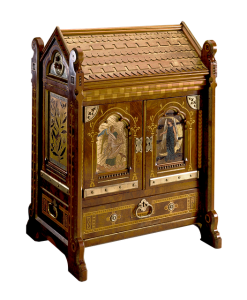
Inlays can be applied to a wide range of small items, including boxes, jewelry, picture frames, and musical instruments. The technique of inlaying small pieces of wood or other materials can be used to create intricate designs and patterns that add a unique and personalized touch to these smaller items.
Inlaid boxes and jewelry are particularly popular, as they can be used to store and display small items in a beautiful and decorative way. Inlaid picture frames are also a popular choice, as they can be used to showcase photographs or artwork in a stylish and personalized way.
Inlaid musical instruments, such as guitars, mandolins, and violins, are also popular among musicians and collectors. Inlay work can be used to create intricate designs and patterns on the instrument’s body, fingerboard, and headstock, adding a unique and personalized touch to the instrument.
In addition to wood, inlays can also be made using a variety of other materials, such as mother-of-pearl, ivory, bone, metal, and even stone. This allows for a high degree of customization and artistic expression, making inlays a popular choice for small items that are meant to be treasured and displayed.
Inlays have been used to embellish a wide range of musical instruments throughout history.
One example is the piano, which often features intricate inlay work on the keys, the cabinet, and the legs. Inlays on pianos can be made of a variety of materials, including wood, mother-of-pearl, and ivory, and they can be used to create a wide range of designs, from simple geometric patterns to elaborate scenes and landscapes.
Another example is the banjo, which often features inlay work on the fingerboard, headstock, and resonator. Inlaid banjos can be highly decorative, featuring designs that range from simple dot patterns to intricate scenes and images.
In addition to the piano and banjo, inlay work can also be found on a range of other musical instruments, including mandolins, ukuleles, drums, and even brass and wind instruments. Inlays can be used to add a decorative element to the instrument, to create a unique and personalized design, or to enhance the functionality of the instrument, such as by creating fret markers on a guitar or mandolin.
Inlays on musical instruments require a high degree of skill and precision to execute, and they can add a significant amount of value to the instrument. As such, inlaid musical instruments are often highly prized by collectors and musicians alike.
Getting Wood Inlays Done
Contact an experienced and trained artisan for your inlay needs
 Custom inlays for guitars are decorative elements that can be inserted in the fretboard, headstock, or body of a guitar to enhance its appearance and uniqueness and are a popular way for guitarists to personalize their instruments and add a unique touch to their appearance. These inlays can be made from various materials, such as mother-of-pearl, abalone, wood, metal, or synthetic materials, and they come in a wide range of designs and patterns. They can take many forms, including intricate designs, patterns, logos, or even personalized artwork.
Custom inlays for guitars are decorative elements that can be inserted in the fretboard, headstock, or body of a guitar to enhance its appearance and uniqueness and are a popular way for guitarists to personalize their instruments and add a unique touch to their appearance. These inlays can be made from various materials, such as mother-of-pearl, abalone, wood, metal, or synthetic materials, and they come in a wide range of designs and patterns. They can take many forms, including intricate designs, patterns, logos, or even personalized artwork.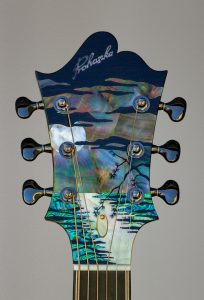 Custom inlays require skilled craftsmanship to create and install. Many professional luthiers or guitar makers offer custom inlay services. It’s important to choose an experienced artisan who can accurately translate your design ideas into a beautiful inlay.
Custom inlays require skilled craftsmanship to create and install. Many professional luthiers or guitar makers offer custom inlay services. It’s important to choose an experienced artisan who can accurately translate your design ideas into a beautiful inlay.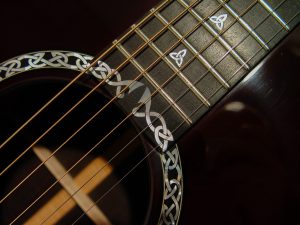 The first step is to design the custom inlay. This can be done by the guitar owner, a luthier, or a specialized inlay artist. The design of the inlay is highly customizable. You can choose various designs, including traditional shapes like dots, diamonds, or block inlays, or more intricate and personalized designs, such as animals, logos, vines, symbols personal initials or intricate scenes. Software programs or hand-drawn sketches are used for the design. Many luthiers and guitar manufacturers offer standard design options, but you can also commission a custom design to make your guitar truly unique.
The first step is to design the custom inlay. This can be done by the guitar owner, a luthier, or a specialized inlay artist. The design of the inlay is highly customizable. You can choose various designs, including traditional shapes like dots, diamonds, or block inlays, or more intricate and personalized designs, such as animals, logos, vines, symbols personal initials or intricate scenes. Software programs or hand-drawn sketches are used for the design. Many luthiers and guitar manufacturers offer standard design options, but you can also commission a custom design to make your guitar truly unique.![]() Inlays can be placed on the fretboard, headstock, or the body of the guitar. Fretboard inlays are the most common and are typically located on the fingerboard to help players navigate the frets. Headstock inlays are often used to display the guitar brand or model name. Body inlays, such as rosettes around the soundhole, are more decorative and less functional.
Inlays can be placed on the fretboard, headstock, or the body of the guitar. Fretboard inlays are the most common and are typically located on the fingerboard to help players navigate the frets. Headstock inlays are often used to display the guitar brand or model name. Body inlays, such as rosettes around the soundhole, are more decorative and less functional. Wood inlays are decorative elements that involve embedding pieces of wood into a larger wood surface to create a design or pattern. Inlays can be made from different types of wood, such as contrasting colors or textures, to create a visually striking effect.
Wood inlays are decorative elements that involve embedding pieces of wood into a larger wood surface to create a design or pattern. Inlays can be made from different types of wood, such as contrasting colors or textures, to create a visually striking effect. Wood inlays are commonly used in guitars, particularly in the fingerboards and headstocks. The most common type of inlay used in guitars is called a “fretboard inlay,” which involves embedding pieces of wood or other materials into the fingerboard to create a design or pattern.
Wood inlays are commonly used in guitars, particularly in the fingerboards and headstocks. The most common type of inlay used in guitars is called a “fretboard inlay,” which involves embedding pieces of wood or other materials into the fingerboard to create a design or pattern. Inlays can be applied to a wide range of small items, including boxes, jewelry, picture frames, and musical instruments. The technique of inlaying small pieces of wood or other materials can be used to create intricate designs and patterns that add a unique and personalized touch to these smaller items.
Inlays can be applied to a wide range of small items, including boxes, jewelry, picture frames, and musical instruments. The technique of inlaying small pieces of wood or other materials can be used to create intricate designs and patterns that add a unique and personalized touch to these smaller items. Inlays have been used for thousands of years to create unique looks for homes and other places. Custom wood inlays are one of the most common types of inlay. It’s a very versatile type of inlay, which means that you can use it in various ways and places. You can also use a wide variety of other materials including stainless steel, shell, stone or even glass in your inlay to give your wood piece a unique finish. Precious stones and metals have also been used as inlays.
Inlays have been used for thousands of years to create unique looks for homes and other places. Custom wood inlays are one of the most common types of inlay. It’s a very versatile type of inlay, which means that you can use it in various ways and places. You can also use a wide variety of other materials including stainless steel, shell, stone or even glass in your inlay to give your wood piece a unique finish. Precious stones and metals have also been used as inlays. A custom inlay is a great way to create custom designs and styles for your home fireplace. This type of design is typically made of any type of wood that you would like, from small pieces of cherry to large pieces of ash wood to pine. You can even have any type of decorative art, such as bird and butterfly designs, etched into the wood, or created with shell or stone through a custom order with an expert in designing, creating and producing inlays.
A custom inlay is a great way to create custom designs and styles for your home fireplace. This type of design is typically made of any type of wood that you would like, from small pieces of cherry to large pieces of ash wood to pine. You can even have any type of decorative art, such as bird and butterfly designs, etched into the wood, or created with shell or stone through a custom order with an expert in designing, creating and producing inlays.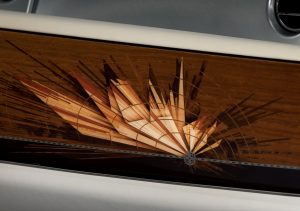 Custom wood inlay is an artistic method of decorating your kitchen cabinets and doors to make them unique. Custom inlays are very popular in the kitchen area, because cabinets are the focal point of this room.
Custom wood inlay is an artistic method of decorating your kitchen cabinets and doors to make them unique. Custom inlays are very popular in the kitchen area, because cabinets are the focal point of this room.